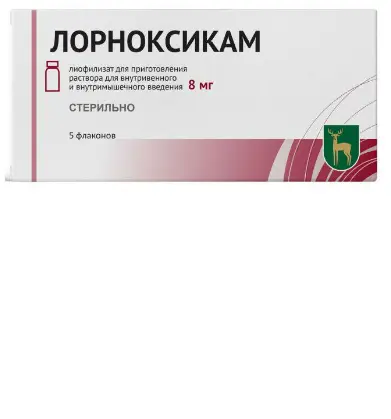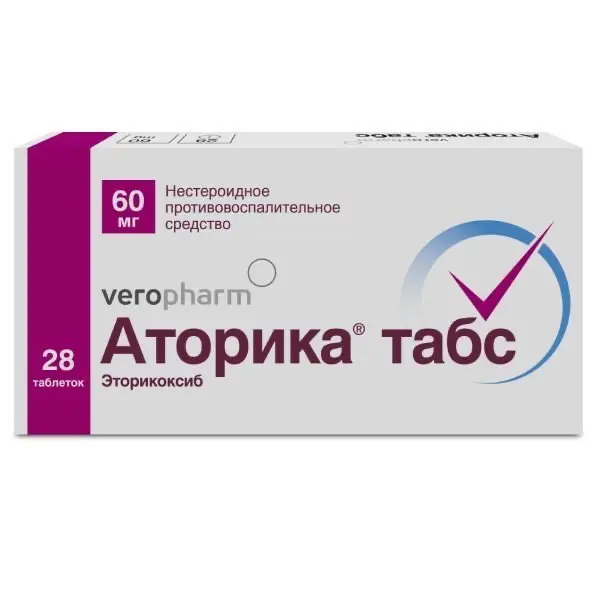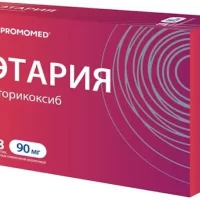Description
Lornoxicam Pharmacodynamics
Lornoxicam is a non-steroidal anti-inflammatory drug, has a pronounced analgesic and anti-inflammatory effect, belongs to the class of oxycams.
The mechanism of action is based on the inhibition of prostaglandin synthesis (inhibition of cyclooxygenase enzyme), leading to suppression of inflammation.
Lornoxicam has no effect on the main indicators of body condition: body temperature, heart rate (HR), blood pressure (BP), electrocardiogram (ECG), spirometry.
Analgesic effect of lornoxicam is not associated with narcotic action.
Lornoxicam has no opiate-like effect on the central nervous system (CNS) and, unlike narcotic analgesics, does not depress respiration, does not cause drug dependence.
Due to the local irritant effect on the gastrointestinal tract (GIT) and systemic ulcerogenic effect associated with inhibition of prostaglandin synthesis, GIT complications are common undesirable effects of treatment with nonsteroidal anti-inflammatory drugs.
Indications
Short-term treatment of mild to moderate acute pain syndrome. Symptomatic therapy of pain and inflammation against osteoarthritis.
Symptomatic therapy of pain and inflammation against rheumatoid arthritis.
Contraindications
Hypersensitivity to lornoxicam or any of the excipients;
Complete or incomplete combination of bronchial asthma, recurrent nasal or paranasal sinus polyposis, rhinitis, angioedema, urticaria and intolerance to acetylsalicylic acid and other NSAIDs (including history);
thrombocytopenia;
hemorrhagic diathesis or clotting disorders, and those who have undergone surgery with the risk of bleeding or incomplete hemostasis;
The period after coronary artery bypass surgery;
decompensated heart failure;
erosive-ulcerative changes of the mucosa of the stomach or duodenum, active gastrointestinal bleeding; cerebrovascular or other bleeding;
history of gastrointestinal bleeding or ulcer perforation associated with taking NSAIDs;
active peptic ulcer or recurrent peptic ulcer in history;
inflammatory bowel disease (Crohn’s disease, ulcerative colitis) in the acute phase;
severe hepatic insufficiency;
severe renal insufficiency (serum creatinine level more than 700 μmol/l), advanced renal disease, confirmed hyperkalemia;
Pregnancy and breast-feeding;
patients under 18 years of age (due to insufficient clinical experience).
Dosage and administration method
- Parenterally.
- Solution for injection is prepared by dissolving the contents of one vial (8 mg lornoxicam) with water for injection (2 ml).
- After preparing the solution, the needle is replaced. Intramuscular injections are made with a long needle.
- So prepared solution is administered intravenously or intramuscularly for postoperative pain and intramuscularly for acute attacks of lumbago/ischialgia. The duration of intravenous injection of the solution should be at least 15 seconds, intramuscular – at least 5 seconds.
- Recommended single dose: 8 mg intravenously or intramuscularly. The daily dose should not exceed 16 mg. Some patients may require an additional dose of 8 mg for the first 24 hours.
- The lowest effective dose should be used for the shortest possible course.
Further information for special patient groups - Children and adolescents
Lornoxicam is not intended for use in children and adolescents under 18 years of age because there are insufficient data on its safety and effectiveness. - Elderly people.
There is no need to specifically adjust the dose in elderly patients (over 65 years of age) if there is no renal or hepatic impairment. The drug should be prescribed with caution, because adverse gastrointestinal events are worse tolerated in this age group. - Renal dysfunction
Patients with mild to moderate renal impairment may require dose adjustment. - Liver dysfunction
Patients with moderate hepatic impairment may require dose adjustment. Undesirable effects can be minimized by using the lowest effective dose of the drug for the shortest period of time sufficient to control symptoms.





